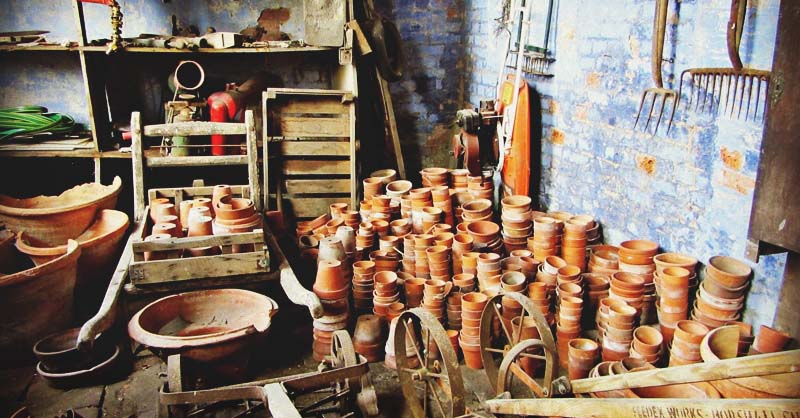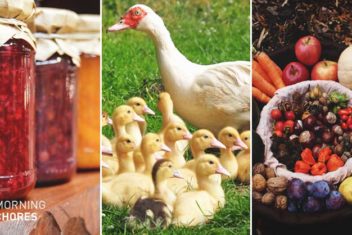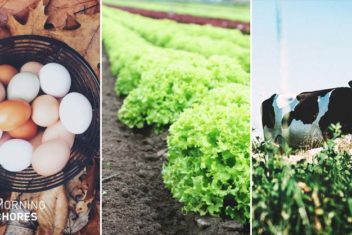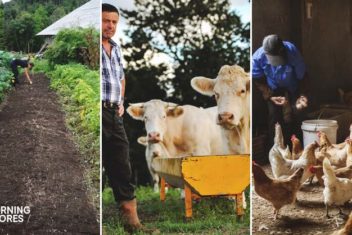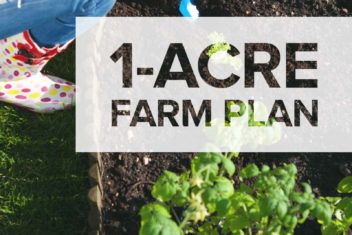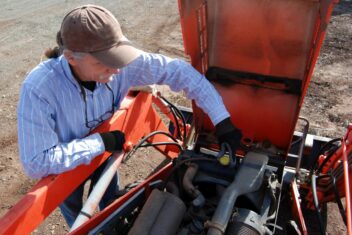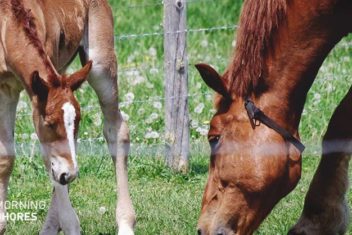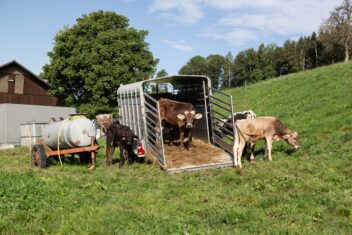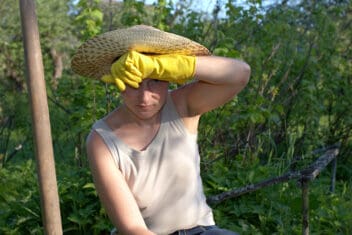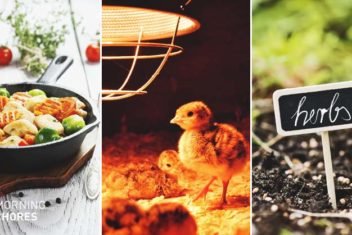I dreamed of having a potting shed for years before I actually got one. I don’t know why, but a potting shed seemed like a symbol of gardening excellence. I felt like I had to have one before I could become a “real” gardener.
In retrospect, I know that view was pretty naive. You can absolutely become a real gardener even if you have to hide your tools in the corner of a closet or under a tarp outdoors. Still, having a potting shed sure does make it easier to store and organize all your garden stuff.
A potting shed is also a great place to do things that are too messy to do in your house. It offers protection from the sun, rain, and wind so you can start garden preparations even when the weather is not so amenable to outdoor work.
In case you are considering adding a potting shed to your homestead, or already have one and want to use it to the fullest, read on for some helpful tips on what to put in your shed and storage ideas.

What is a Potting Shed?
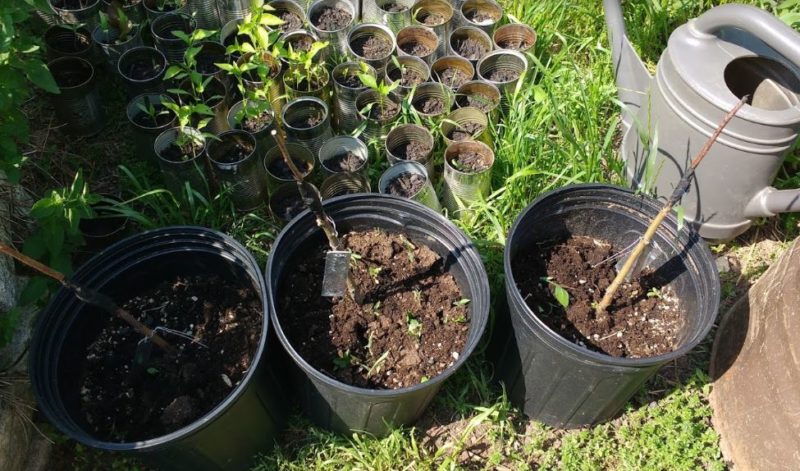
First off, in case you are new to gardening, you might be wondering what the heck is a “potting shed”. A lot of people have sheds to store their garden and lawn tools, but that doesn’t actually qualify as a ‘potting shed.’
The thing that makes a potting shed different than other sheds in your yard, is that it functions as a place to keep your potting soil, where you pot your new plants and start seedlings, and store your pot collection for easy access. So, by definition, a potting shed requires three things.
1. A Potting Table
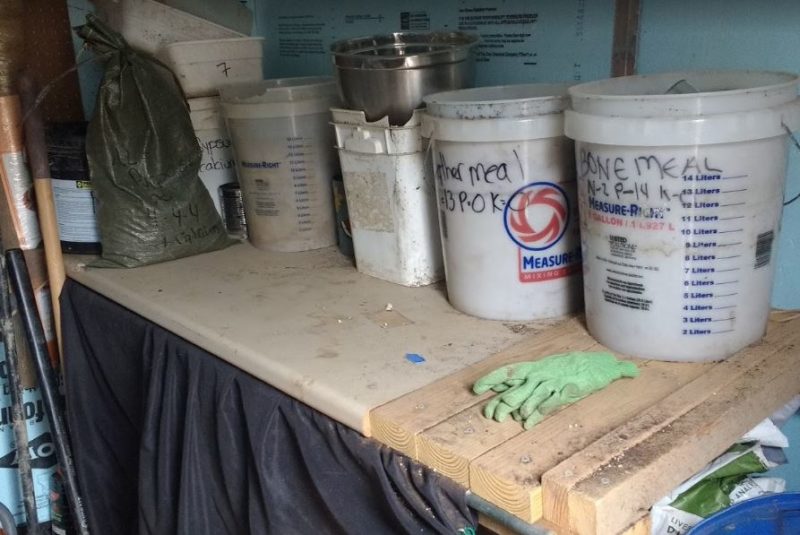
Potting tables come in many forms and shapes. Mine is some old kitchen counter tops salvaged from a kitchen re-do and put into service as my potting table.
They can be slatted or solid, painted or not, built in or free-standing. They can be decorative or functional. The only real criteria for a useful potting table is that it makes it easy for you to pot your plants and start your seedlings.
You probably also want it to be easy to clean. I just clean mine using a hand broom and dustpan. But, if you work with any kind of potentially toxic substances like weed killer, or pathogenic plants, you may also want to be able to wipe your table with water and other cleaning supplies.
Height-wise, I like to stand up to do my potting. So, I prefer to have my table about the same height as my kitchen counters. But, if you can’t stand for long periods, you may want to consider making yours like a desk so you can sit while you work.
2. Potting Soil
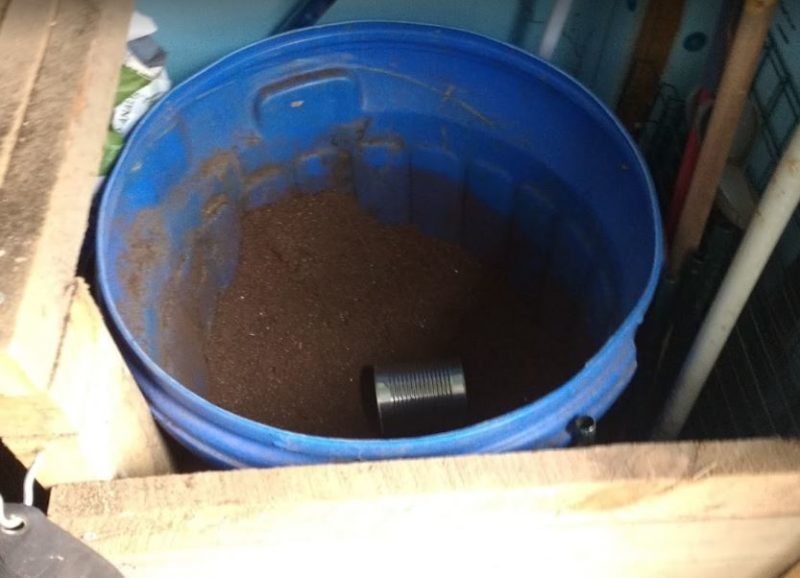
Whether you make your own potting soil or buy it ready-made, it’s easier to work with if you can scoop it from a wide-mouthed container. That’s why most of us tend to put our potting soil in outdoor trash cans.
Particularly if you make your own potting soil, making it in advance and letting the ingredients meld is important. The bacterial life in your compost will start to form relationships with your coconut coir, and other amendments.
Then, a few months later when you start using your potting mix, all the ingredients have learned to live and work together in harmony for the benefit of your new plants. So, planning long-term storage for your potting soil is helpful, especially to organic gardeners.
If you don’t want to lean over to reach to the bottom of a deep container, you can also use shallower totes to hold potting soil. If you use totes with lids, you can stack them on top of each other. That way the one you are currently using can be high enough to make scooping out soil easy.
3. Pot Storage
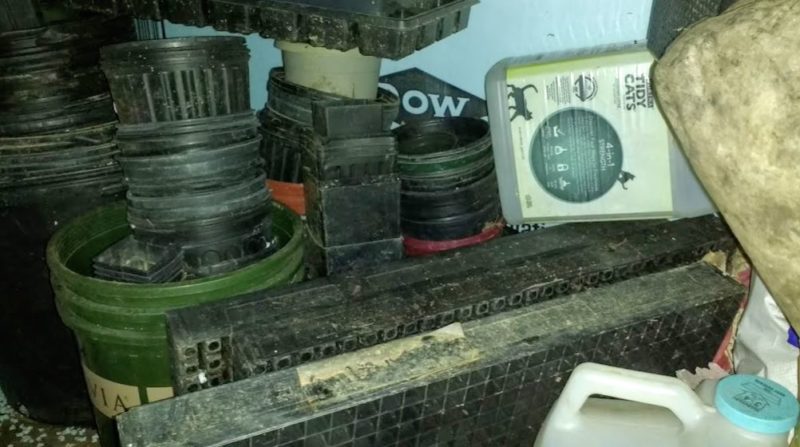
I love those photos of pretty potting sheds with beautiful terra cotta pots, wooden flats, or hypertufa planters. The reality though is that plastic pots and trays are far more common. They weighs less, costs less, and are easier to sterilize when necessary.
That said, plastic pots are ugly. I hate to look at them. So, in my potting shed, pot storage actually means pot hiding. I have
Since I do most of my own propagation at this point, I don’t buy many plants any more.
So, I have also have started using pots and trays made out of all sorts of other not entirely pretty materials. Sour cream containers with holes punched inside, dish pans with drainage holes, broken totes turned into seedling flats, and more hide in my potting shed.
If you can afford pretty pots and don’t mind the heavy lifting, more power to you! But if not, consider places to hide and store your pots in your potting shed.
Beyond the “Potting” Aspect of the Potting Shed
Now, a potting shed is also still meant to be a shed. In particular, it’s a shed that you use for garden related stuff. So, once you’ve met the “potting” criteria and created a place to start new plants or upgrade old plants to new pots, there are several more things to consider.
4. Hand Tools
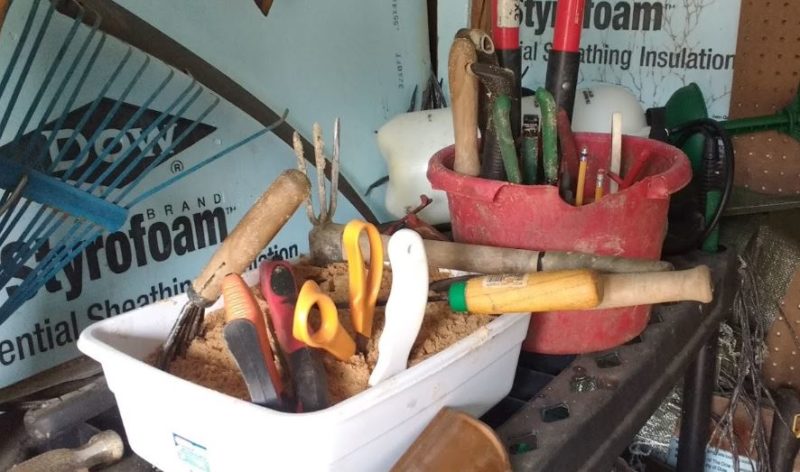
I don’t know about you, but I have about 4 pairs of pruning shears. I could get by with one. However, I have a bad habit of leaving them where I am pruning and then forgetting where I left them. So, I just find it easier to grab another pair and track down my missing instruments later.
For me, those pretty peg boards and hand tool hangers get a bit irritating when you have multiples of each tool. Instead, I use buckets of oiled sand for hand tool storage. It takes about ¼ cup of mineral oil for each gallon of sand.
Once you mix them together in a bucket, you can just poke the metal parts of your tools into them for storage. The sand cleans and the oil protects against rust.
Whether you go with pretty hangers or practical buckets, planning storage for your much needed, often under-appreciated hand tools is a must in a potting shed.
5. Standing Tools
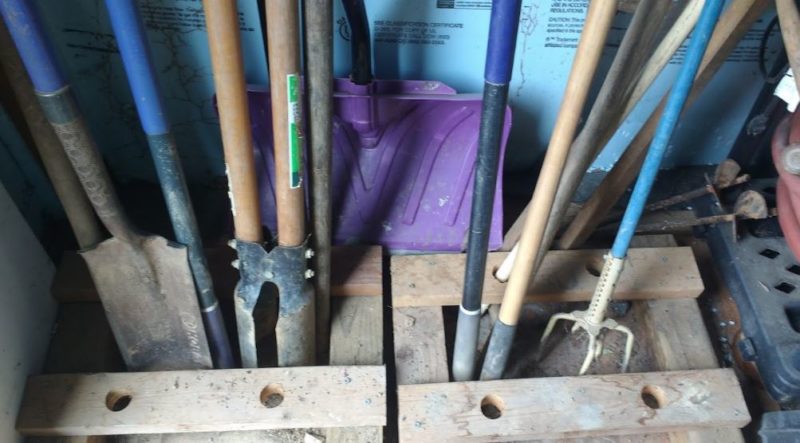
All those various shovels, rakes, tillers, and such that you use while in a standing position also need a safe home to protect them from the elements. Because they come in so many shapes and sizes, it can be a bit challenging to figure out how to store them.
For me, the easiest system is one where you can see the tool heads without having to move things around. I also like the sharp parts to be pointed away from me so that if we had an earthquake, or large aircraft fly-by, they couldn’t fall over in my direction.
I tried putting the stick ends in holes. But I discovered that even among shovel and rake handles there are large variations in handle-size.
Also, if you have a low ceiling, make sure you don’t have to lift your tools high to fit them in the slots you make. I used a half 55-gallon drum for a while to put my tools in. However, it was hard to lift the tools above the 30-inch high barrel rim to put them inside without bumping the
Now, I just use open slots, a few inches off the ground, to keep the tools from sliding forward into my walking area. I face most tool heads up to make locating them easy. Some tools, though, like a post hole digger and tiller, stand better with their tool heads on the ground.
6. Soil Amendments
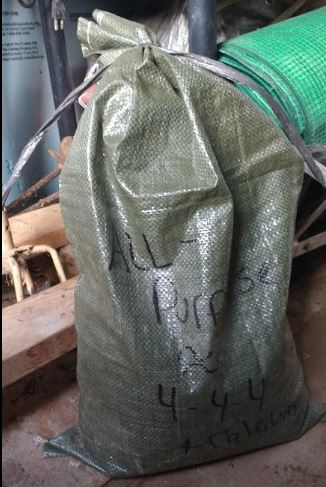
Whether you make your own fertilizer mixes or buy them pre-made for you, you need to store them in a dry location out of direct light. Your potting shed can work great for that. If you do make your own amendments, you can put your amendments in containers with clear labels to make them easy to access.
Also, note that things like horticultural oil or neem oil need to be kept at temperatures similar to what we humans like to have in our climate-controlled homes. So, you may not want to store oils or liquid fertilizer that shouldn’t freeze or experience heat extremes in your unheated shed.
7. Hoses and Irrigation Supplies
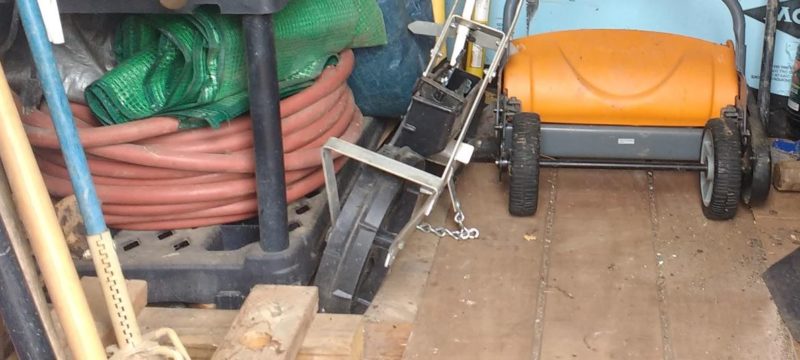
You may want to think about storing your hoses and irrigation equipment in your potting shed when not in use. Hoses last longer if you bring them in during cold weather.
All your extra irrigation tubing also fares better when kept out of direct sunlight unless it’s in use. If you are old-school like me and water your plants with watering cans, then your potting shed is also a perfect place to put your can collection during the off-season.
8. Seeds
Some potting sheds are also suitable as a location to store your seeds. I have a bit if a mouse problem in mine. So I could only do that if I used a metal box. Instead, I keep my seeds in my homestead office.
But if you do keep your seeds in a pest proof box and your shed is climate controlled enough that it doesn’t have huge temperature swings, then it might also be suitable for seed storage.
Remember seeds are dormant, but living things though. So treat them about like you would delicate horticultural oils.
9. Miscellany

We all have a collection of small tools and such that don’t really fit well into other categories. I have seed planting tools that don’t fit in with my hand or standing tools. I also have a large collection of various kinds of garden twine that I keep in a bucket.
Then there are plant labels, clothespins, plastic bags, small containers for different tasks…Oh and let’s not forget all the tarps and plastic sheeting used to pre-warm soil or suppress a weed outbreak. Plus, there’s the weed mat and burlap for certain applications. I could go on. But I think you get it!
Every gardener has a whole lot more miscellany to put in their sheds than organization experts seem to realize! Personally I keep a collection of buckets and an entire shelving unit for all my garden miscellany.
You may need more or less space than me. But do yourself a favor and allow plenty of space to flexibly fit your evolving storage needs!
Beyond The Standard Potting Shed Uses
Some times people just want everything related to their entire outdoors in one place. A typical potting shed revolves around gardening and not really lawn care.
But, if you want to have a one-stop shop for all things outdoors, then you might want to consider a size upgrade to the typical potting shed. If you go big, then you might be able to fit in some of these items.
10. Big Garden Equipment
If you have a big enough potting shed, you may even be able to store things like your gas lawn mower, wheelbarrow, and more in your space. Those large items usually need to have dedicated parking spots within the shed.
They are often best located near to the entrance so you can get them in and out of your shed without accidentally disturbing your other tools.
Trust me, the further they are from the door, the more swearing you will do when you truck them in and out!
11. Seed Starting Space
Even though we pot up our seedlings in our potting shed, generally we move them outdoors or to a greenhouse to get sufficient light for germination.
However, if you have the room and electricity, putting some grow lights and keeping a dedicated seed starting area can make seed starting even easier!
12. Overwintering Plants
Many of our potted plants need to come in over winter to be protected from frosts and freezing conditions. If your shed is climate controlled and well-lit, this can also be a great place to store your more delicate potted plant friends.
Sometimes people even attach greenhouse areas to their potting sheds to facilitate this kind of storage. Make sure you do your research and planning on that first though.
Heating is usually required to gain more than one USDA zone of climate control. Also, greenhouses get hot fast on sunny days unless the windows are open.
13. Decorative Items
If you use things like cloches, metal art, whirlygigs, or other decorative items in your garden (e.g. your potager) during the growing season, winter storage might be needed.
A potting shed can be a good spot for these items too.
Also, things like cushions and throws for your outdoor furniture often need inclement weather storage. Consider keeping these in your potting shed too.
14. Plant Preservation
If you dry herbs, press flowers in books, or preserve flowers for winter bouquets, your potting shed can help! Doing these kind of activities can add beauty and interest to an otherwise practical and boring space.
Consider using walls or high ceiling areas as drying racks. Or, install book shelves above your tools.
15. You!
You’ve heard of the “He-Shed” or “She-Shed” right? Sometimes we just need a space of our own away from the rest of the household. Many homesteaders and gardeners make their potting sheds large enough to accommodate their personal time too.
Having a place to sit and read a book, make your garden plans, or just inhale the scent of potting soil is a wonderful use for a potting shed!
Conclusion
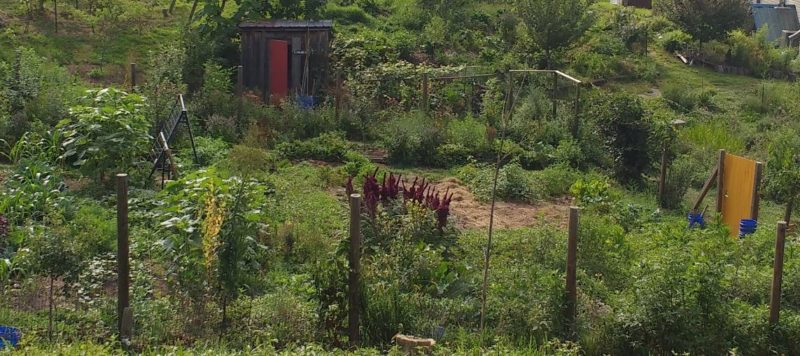
You don’t need a potting shed to be a “real” gardener. But having one certainly makes large scale gardening a whole lot easier. So if you don’t already have one, hopefully I’ve given you a few reasons to consider adding one to your homestead line up!
Happy potting, planting, and more!
